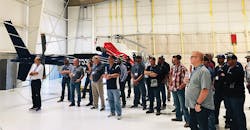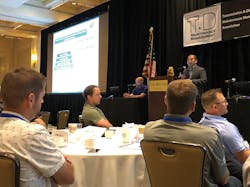Linemen, engineers, substation technicians and field managers came together in Pasadena, California, for a single mission — sharing strategies — at the 44th annual Transmission Distribution Maintenance Management (TDMMA) conference.
It didn’t make a difference if the attendees hailed from large utilities or small municipalities, from the United States or Canada, or from the line trade or engineering department, during TDMMA, they were all part of the same family, working together to identify problems and devise solutions. A record number of attendees — 178 — registered for this year’s event, and many of the registrants were first timers.
“People bringing new people in keeps the conference going,” said Andrew Kendall, senior assistant general manager power system, construction, maintenance and operations for the Los Angeles Department of Water and Power (LADWP), the host utility. “I’ve been to a lot of different conferences in the industry, but this is the one that I see as the most valuable. It’s not just the information that you get during the conference, but it’s also the relationships that you build. You can meet people who do the same things and face the same problems.”
Kendall said he got involved in TDMMA after he faced a challenge, and his coworker suggested that he turn to the organization.
“We sent out an email, and we soon had 40 responses,” Kendall recalled. “That’s what this is all about — being able to share honestly and know that we are in the same boat and can work together.”
Embarking on a Technical Tour
Like past conferences, this year’s event kicked off the week with a technical tour. With such a high number of attendees, the TDMMA host committee had to turn potential registrants away for the sold-out excursion, said Karyn Grime, administrative manager, Power Executive Office for LADWP.
The attendees who were able to register ahead of time for the technical tour boarded one of two buses to travel to two different destinations. On one part of the tour, the attendees could observe LADWP’s new Human External Cargo (HEC) program in action at the Hokinson Heliport.
Within a large hangar, the power industry professionals inspected the equipment required for HEC, sat in an Air Chair suspended from the back of a LADWP bucket truck and took a close look at the helicopters used for the work practice. While the attendees watched from inside the hangar, the HEC team walked outside the heliport building to give a demonstration of the long-lining method. Using the HEC method, the pilot then lifted a lineman off the ground, positioned him on the tower and then flew back to pick him up and take him back to the starting spot. The team also demonstrated how to perform a rescue via a helicopter.
Robbie McIntosh, manager of transmission lines, North Group for AltaLink, who also attended the TDMMA conferences in Alberta, Canada, and Myrtle Beach, South Carolina, said he enjoyed the HEC demonstration.
“A lot of us have hopes to do it because it’s a safer and more efficient ways to do work,” McIntosh said. “I’d like to send one of our guys down here to LA to observe and use it for our program.”
Following a bus ride through a canyon, the registrants enjoyed an outdoor BBQ lunch in Exhibit Park followed by a tour of LADWP’s oldest power plants — San Francisquito Power Plant #1. Along the way, they had the opportunity to learn about the history of the company. Within the park area, they viewed a section of the original First Los Angeles Aqueduct, a cable-winding reel and a reaction turbine removed from service. Outside the entrance of the power plant, they peeked into the historical vehicle building, which housed a vintage tool trailer discovered on the mountainside, an early model of a cable stringer and a horse-drawn transformer oil-filter trailer.
Once inside the power plant, they walked past the green hydroelectric plant equipment and up the stairs to a museum, which featured more memorabilia from the early days of LADWP. Next, they walked down the stairs and up into a control room, where a control room operator explained the purpose and mission of the 70 MW capacity hydroelectric plant, which opened more than a century ago.
Building Connections
During the week-long event, the attendees had the opportunity to not only attend the technical tour, but also attend an informal reception in the executive suite, a Meet and Greet at a neighborhood billiard hall and several gatherings near the pool at the hotel or local venues. The spouses of the attendees could also bond with one another through specialized guest experiences such as a tour of Los Angeles and a visit to a winery or the shops of Pasadena, California.
Sean Veley, power supervisor for Tacoma Power, said this year’s conference was his first time attending TDMMA. After working as a substation electrician and journeyman, the Navy veteran recently moved into management and shifted into the substation group.
“I’m here to soak it all in, listen and talk to people,” Veley said. “I want to know if other people are faced with the same or different problems in different facets.”
Wes Horne, maintenance supervisor for Arizona Public Service, said he’s discovered that there are a million ways to do the same task, and many of the companies have already figured out the best way to solve a certain problem. He can then take that knowledge back to his leadership team to improve productivity and safety at his own company. At the conference, he said there is a blend of different types of attendees — from linemen to foremen to directors and superintendents, which is valuable.
“We all have different perspectives and we can learn a lot from one another,” Horne said.
Mandeep Parmar, lead electrical engineer for the City of Red Deer Electric Light and Power in Canada, agreed, saying the conference gives attendees the opportunity to meet individuals in different positions and ask questions.
“There is a free flow of information, and everyone is willing to help,” Parmar said. “It helps you keep your finger on the pulse of everything.”
Learning About Best Practices
Over the course of three days, the attendees could earn continuing education credits and learn about a variety of topics including asset management and EPZ bonding. As in past years, the conference also featured panel sessions on major challenges and successes and failures and safety to allow attendees to share their experiences overcoming a particular challenge or dealing with an emergency situation. For example, the speakers shined the spotlight on the recent Nebraska floods, a wind storm in Salt River Project’s service territory and the “Manitoba Ice Wars.”
This year’s new technologies panel featured presentations on dielectric rope, distribution automation and UAV use in the utility environment. Shawn Reimer, manager of substations for AltaLink, gave a presentation on how his company is using two waterproof military-grade drones with thermal imaging capabilities to conduct site-specific inspections.
“In Canada, drone operators can go beyond line of sight in rural areas by obtaining a special permit from Transport Canada,” he said.
Sharing Views
The conference featured panel sessions in the mornings followed by interactive workshops and open forums in the afternoons. The afternoon sessions allowed the attendees to take a deeper dive into the issues presented during the morning panel discussions.
During a workshop on workforce management, the attendees voiced concerns about not only recruiting the next generation of linemen, but also retaining apprentices after they have completed their training. Some utilities are requiring apprentices to sign contracts while others are offering them sign-on bonuses.
The attendees also explored strategies on how to encourage linemen to step away from the field and move into management roles at their companies. San Diego Gas & Electric’s Charlie Tuck, who moderated the panel along with Alan Katz of Colorado Springs Utilities, said his company allows employees to try out management opportunities through a process called “blue slipping,” in which they spend a six-month rotation in the office.
With no vendors present, the power industry professionals had the freedom to speak their minds about the topics at hand and learn from one another about what works and what doesn’t work in terms of tools, technology and work practices. “There’s not many places where we can network with people that do what we do,” Katz said.
During the open forums, the attendees split off into three different sections — transmission, distribution and substations — which allowed them to connect with other registrants in their work group and get their questions answered on the spot. McIntosh said at TDMMA, everyone is open to sharing.
“The beauty of this conference is being able to share back and forth,” he said. “We are not competing against one another, and we are all working for the common good.”
Editor’s Note: To see a photo gallery from the event, visit www.tdworld.com/electric-utility-operations. Visit www.tdmm.com to learn about next year’s conference, sponsored by Sask Power, in Saskatoon, Saskachewan, Canada.



